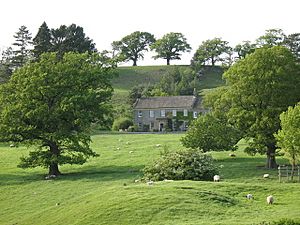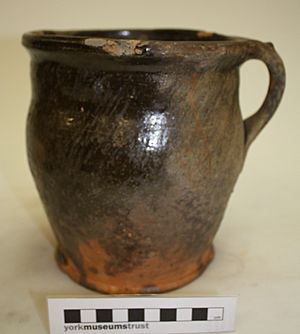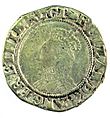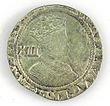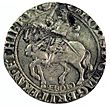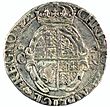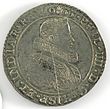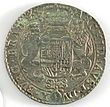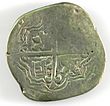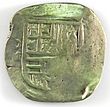Middleham Hoard facts for kids
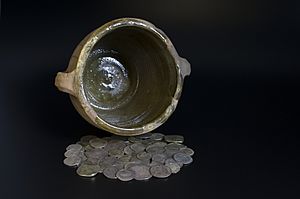
A selection of the hoard's coins now in the Yorkshire Museum
|
|
| Location | Middleham, North Yorkshire, England |
|---|---|
| Coordinates | 54°16′47″N 1°50′24″W / 54.27972°N 1.84000°W |
| Type | Hoard |
| History | |
| Events | Buried in the 1640s |
| Site notes | |
| Excavation dates | 1993 |
| Archaeologists | Analysed by Craig Barclay |
The Middleham Hoard is a huge collection of old silver coins found near Middleham, a town in North Yorkshire, England. This amazing treasure dates back to the time of the English Civil War in the 1640s. It holds 5,099 silver coins, making it the biggest collection of coins from that war ever discovered!
A metal detector enthusiast named William Caygill found the hoard in June 1993. Even though it's called one hoard, the coins were actually buried in three different pots. These pots were hidden in two separate spots. They were likely buried at slightly different times in the late 1640s, but probably by the same person or family. Today, these coins are spread out in museums and private collections. Fifty-four of them are now part of the coin collection at the Yorkshire Museum.
Contents
How the Hoard Was Found
William Caygill, who loved using his metal detector, made this exciting discovery on June 22, 1993. He found the coins on the land of Cotescue Park, which is on the edge of Middleham.
First, William found two of the pots, which we call Pot A and Pot B. He came back two days later and found the third pot, Pot C. What an exciting find!
Where the Coins Were Hidden
The pots were found at Cotescue Park. This place used to be a special hunting lodge for royalty. It's located just north of the town of Coverham, about 2 kilometers (1.2 miles) southwest of Middleham Castle.
During the 1600s, Cotescue Park was the home of Sir Christopher Croft. He was an important person who served as the Lord Mayor of York twice. Another important person, Adam Loftus, who used to be a top legal official in Ireland, lived nearby in Coverham until he passed away in 1643. His son, Edward Loftus, lived in Middleham Castle until 1644. After that, the castle was used as a prison. Even though Middleham Castle didn't see any battles during the Civil War, parts of it were taken down after 1646 so it couldn't be used by soldiers.
Two of the pots (A and B) were found close together. The third pot (C) was found about twenty steps away to the west. All three pots were covered with a flat stone lid made from local rock.
The newest coins in Pots A and B were from 1645–1646. This suggests they were buried around 1646. Pot C had some coins with a later picture of King Charles I that weren't in Pots A or B. It also had a coin with a special "sceptre" mark used from 1646 to 1649. This means Pot C was likely buried a little later, maybe in 1648. However, because all three pots were found so close, it's thought that the same family buried all of them.
The Pots That Held the Treasure
The three pots used to hide the coins were common kitchen jars from the mid-1600s. They all had handles and would have been used for storing food, not for cooking.
Pots A and B look very similar. Pot A has been identified as a type of pottery called Ryedale ware. Pot C is a bit different from A and B and came from a different, unknown place.
The Coins of the Hoard
The Middleham Hoard contains a wide variety of coins! Most are English coins from the reigns of Edward VI to Charles I. There are also some Scottish and Irish coins. What's really interesting is that there are coins from Philip IV of Spain and his governors in the Spanish Netherlands. There are even 39 fake coins!
The total value of all the coins was over £312, which was a lot of money back then. Out of the 5,099 coins:
- 4,772 were English
- 31 were Scottish
- 10 were Irish
- 245 were from "Spanish possessions in Europe" (all from the Netherlands)
- 2 were from the Spanish New World
One special thing about this hoard is the large number of Spanish coins. There are 247 coins from the Spanish Netherlands and Spanish America. While they make up less than 5% of the total number of coins, they were very valuable. For example, a ducaton (a Spanish coin) was worth five shillings and sixpence. The Spanish coins made up about 20% of the total value of the entire hoard! Spanish coins were mostly used in areas that supported the King during the Civil War. Other hoards from Yorkshire have also had Spanish coins, but none have as many as the Middleham Hoard.
Another interesting part of the hoard is the 39 fake coins. Most of these fakes were found in Pots A and B (only six were in Pot C). Most of the fake coins were copies of English coins from that time. However, Pots A and B also had fake Spanish-American reales. These might have been faked because the real ones were often poorly made and not many people would have known what they looked like.
Two of the three fake Spanish-American coins in Pot A were made using the same mold. The two fake Spanish-American coins in Pot B were also made from the same mold. This suggests that these fake coins might have been made locally, close to where they were found. It's also possible that some of the fake English coins, like a copy of a Charles I shilling from the York mint, were made nearby too.
The table below shows how many coins from different rulers were found in each pot.
| Reign | Example coin | Pot A | Pot B | Pot C | ||||||
|---|---|---|---|---|---|---|---|---|---|---|
| Edward VI (England) | 6 | 10 | 4 | |||||||
| Mary I (England) | 0 | 0 | 2 | |||||||
| Philip and Mary (England) | 9 | 9 | 8 | |||||||
| Elizabeth I (England) |
|
492 | 775 | 542 | ||||||
| James I (England) |
|
151 | 279 | 169 | ||||||
| Charles I (England) |
|
524 | 952 | 840 | ||||||
| James VI (Scotland) | 6 | 17 | 0 | |||||||
| Charles I (Scotland) | 3 | 4 | 1 | |||||||
| Elizabeth I (Ireland) | 0 | 1 | 0 | |||||||
| James I (Ireland) | 1 | 6 | 2 | |||||||
| Spanish Possessions (Europe) |
|
53 | 150 | 42 | ||||||
| Spanish Possessions (America) | 2 | 0 | 0 | |||||||
| Counterfeit |
|
16 | 17 | 6 | ||||||
| Total | 1,263 | 2,220 | 1,616 | |||||||
Many of the coins had been clipped. This means small pieces of metal were cut off the edges of the coins. The older the coin, the more likely it was to have been clipped.



